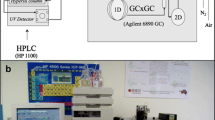Abstract
Trace level analyses in complex matrices benefit from heart-cut multidimensional gas chromatographic (MDGC) separations and quantification via a stable isotope dilution assay. Minimization of the potential transfer of co-eluting matrix compounds from the first dimension (1D) separation into the second dimension separation requests narrow cut-windows. Knowledge about the nature of the isotope effect in the separation of labeled and unlabeled compounds allows choosing conditions resulting in at best a co-elution situation in the 1D separation. Since the isotope effect strongly depends on the interactions of the analytes with the stationary phase, an appropriate separation column polarity is mandatory for an isotopic co-elution. With 3-alkyl-2-methoxypyrazines and an ionic liquid stationary phase as an example, optimization of the MDGC method is demonstrated and critical aspects of narrow cut-window definition are discussed.

Avoiding chromatographic separation of isotopic standards by fine-tuning the isotope effect allows narrow cut-windows in SIDA based MDGC applications.


Similar content being viewed by others
References
Marriott PJ, Chin S-T, Maikhunthod B, Schmarr H-G, Bieri S (2012) Multidimensional gas chromatography. TrAC, Trends Anal Chem 34:1–21
Rychlik M, Asam S (2009) Stabilisotopenverdünnungsanalysen zur Quantifizierung organischer Spurenkomponenten in der Lebensmittelanalytik. Umweltwiss Schadst-Forsch 21(5):470–482
Schmarr H-G, Slabizki P, Müntnich S, Metzger C, Gracia-Moreno E (2012) Ionic liquids as novel stationary phases in gas liquid chromatography: inverse or normal isotope effect? J Chromatogr A 1270:310–317
Schmarr H-G, Sang W, Ganß S, Koschinski S, Meusinger R (2011) New insights into the synthesis and characterization of 2-methoxy-3-alkylpyrazines and their deuterated isotopologues. J Labelled Compd Radiopharm 54(8):438–440
Schmarr H-G, Ganß S, Sang W, Potouridis T (2007) Analysis of 2-aminoacetophenone in wine using a stable isotope dilution assay and multidimensional gas chromatography-mass spectrometry. J Chromatogr A 1150(1–2):78–84
Acknowledgments
The authors are particularly grateful to Supelco (Sigma-Aldrich; SILEP program) for the ionic liquid separation columns evaluated in this work. C. Legrum is grateful to the “Graduiertenförderung des Landes Rheinland-Pfalz” for a Ph.D. scholarship. Also, financial support from the Ministerium für Umwelt, Landwirtschaft, Ernährung, Weinbau und Forsten (Rheinland-Pfalz, Germany) is gratefully acknowledged.
Author information
Authors and Affiliations
Corresponding author
Additional information
Hans-Georg Schmarr and Charlotte Legrum contributed equally to this work.
Rights and permissions
About this article
Cite this article
Schmarr, HG., Slabizki, P. & Legrum, C. Optimization in multidimensional gas chromatography applying quantitative analysis via a stable isotope dilution assay. Anal Bioanal Chem 405, 6589–6593 (2013). https://doi.org/10.1007/s00216-013-7072-1
Received:
Revised:
Accepted:
Published:
Issue Date:
DOI: https://doi.org/10.1007/s00216-013-7072-1




